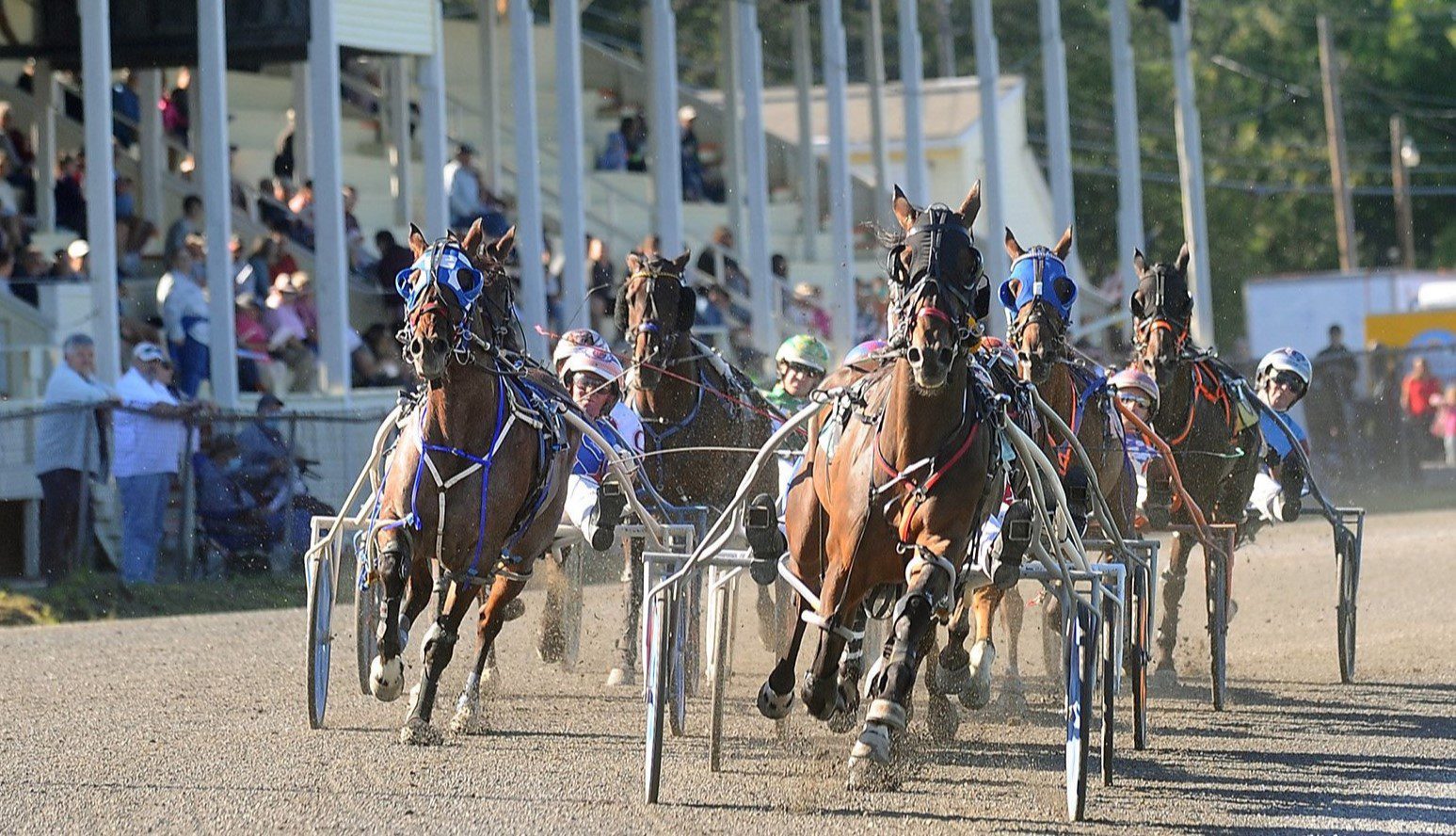Lurking beneath one of Maine’s iconic pastimes, harness racing at county fairs and commercial tracks, lies an ugly underside — scores of instances of illegal horse drugging and physical abuse.
The Maine State Harness Racing Commission, which regulates the long-standing betting sport, has sanctioned licensed owners, drivers and trainers more than 600 times since 2016 for violating rules aimed in part at keeping horses fit and able to compete, MSHRC data shows.
The largest number of fines was levied against owners, trainers and drivers who raced at two commercial tracks, Bangor Raceway and Scarborough Downs; the Scarborough Downs track closed in 2020. The state also found violations at First Track (Cumberland Fair), Fryeburg Fair Race Track, Farmington Fair, Windsor Fair, Skowhegan State Fair, Union Fair and Topsham Fair. Violations also were found at Oxford County Fair, which stopped racing in 2017, and Northern Maine Fair in Presque Isle, which stopped in 2020.
The violations include excessive use of whips, illegal kicking and striking horses hard enough to leave welts — or red, swollen marks on the flesh, the data shows.
Since 2016, horses suffered 23 kicks, 34 whips and 10 welts during race time, state data shows.
More than 130 violations were for impermissible levels of drugs found in horses, who are tested before each race. Those included the hormone testosterone, the anti-inflammatory drugs flunixin and phenylbutazone, which can reduce pain in horses, and dexamethasone, which helps treat allergic reactions and arthritis, the records show.
Owners, trainers and drivers — some of whom are multiple repeat offenders — have paid over $105,000 in fines to the MSHRC for the infractions since 2016, according to the data. Licensed owners have also had to forfeit their winnings — sums awarded to the top five finishers in a race — for violating Maine’s prohibited substance rule, the records show.
Harness racing has a long history in the U.S., with the first tracks appearing in the mid-1800s, according to the United States Trotting Association, the sport’s governing body. In Maine, harness racing began after the Civil War and has become a much-anticipated feature at two commercial racetracks and local agricultural fairs each year. Seven hundred standardbreds raced across Maine in 2022, according to the USTA.
Standardbred horses, broken down as trotters or pacers, depending on their gait, race over 30 miles per hour, pulling a two-wheeled cart carrying a driver that is called a sulky, reminiscent of chariot racing in ancient Rome.
While it began as a “traditional sport,” the spirit of harness racing has changed from its origins, said Robyn Cuffey, spokesperson for Futures for Standardbreds, a nonprofit that retrains and rehabilitates retired standardbreds in southern Maine.
Harness racing “has a very innocent beginning,” Cuffey said, adding the sport began as people racing their horse carriages home from church as a leisure activity. “Once money got involved … it gets a little less innocent,” Cuffey said.
Shane Bacon, the MSHRC executive director, said the number of violations issued means regulators are doing their job, though he would like to see more aggressive regulation.
“The rules are only as good as the people who are officiating the races,” Bacon said. “If you have the best rules, but you don’t have an official who is doing his job, that’s when you can come into problems.”
Bacon said the state has a vested interest in keeping the standardbreds healthy and safe.
“There is an economic benefit from racing and caring for horses by means of employment of people who work at tracks and the food that they consume, but we, as the state, care about the horses — period,” he said.
“From an economic standpoint, these are animals that have to be taken care of,” he said. “Many jobs trickle down from these horses.”
Harness racing has generated over $221 million for the state over the past five years, Bacon said.
Don Marean, a former state representative and current commission board member, said the MSHRC operates largely from slot machine revenue generated from casinos in Oxford and Bangor rather than an allotment from state general funds.
“We, the industry, are supporting and regulating, and governing ourselves with our own money,” said Marean, who is also chairman of the U.S. Trotting Association District 9, a nonprofit racing industry organization.
Because harness racing generates revenue, regulators are determined to preserve it — even as the number of racehorses has steadily decreased.
In Maine, each standardbred racehorse earns an average of $8,602 a year, with an average of 851 horses racing each year since 2013, USTA data shows.
Last year, only 669 standardbred horses raced in Maine, but the average earnings per standardbred rose to $11,613, according to the USTA.
Bacon said he plans to issue more suspensions to errant owners and trainers rather than just impose fines, to discourage rule-breaking and better safeguard the animals.
“The commission’s sole priority is to protect the resources and the betting public,” Bacon added. “We have continual meetings with judges to ensure that they’re all officiating the game correctly, and that’s the best way to protect resources.”
Bacon also said the MSHRC takes other steps to protect horses, including canceling races on brutally hot days or when the track is in poor condition because of a rainstorm.
“We are 100% committed to protecting horses,” Bacon said.
According to Chapter 7 of the Maine State Harness Racing rules, any licensees under commission jurisdiction “shall not knowingly subject or permit any animal under his/her control, custody or supervision to be subjected to or to incur any form of cruelty, mistreatment, neglect or abuse or abandon, injure, maim or kill or administer any noxious substance to or deprive any animal of necessary care or sustenance, shelter or veterinary care.”
But industry critics said some racehorses are torn from their mothers when they are 1 year old, sold and trained to earn money for their owners.
“Racehorses are thrust into intensive training at 18 months, so years before their bodies are fully formed,” said Patrick Battuello, the founder of Horseracing Wrongs, an organization that works to put an end to the horse racing industry.
“If they are not racing, they are not earning. It’s all about getting them on the track as quickly as possible,” Battuello said.
Animal advocates, including those who rescue retired racehorses, said the sport fails to provide adequate funding to care for the over-exercised animals, who often leave the racetrack at the end of their careers in dismal physical shape.
Eleanor Melanson-Dubois of Biddeford, who adopted a standardbred ex-racehorse in 2021 from Hearts and Hooves Rescue and Sanctuary, said the organization first rescued him from the kill pen — a cramped holding place where horses are being auctioned for slaughter — and took care of the horse, who was severely underweight and with many health complications.
“His teeth are worn down far beyond his years. That’s how bad it is,” she said. “So, you know, for a horse that’s 17, the vet’s thinking … his teeth look like he’s in his late 20s.”
Marean said the Maine Harness Horseman’s Association, an organization representing owners, breeders, trainers and drivers of standardbred horses in Maine, allocates $5,000 annually to help care for horses. Those include retired standardbreds that need homes — and are either taken by animal welfare organizations, the state, the county or local governments.
“Horse racing is a business, it’s not about pets,” Marean said. “Not only that, racehorses get much better care than a lot of backyard pets. They get the best of everything.”
This story was produced in Boston University Professor Maggie Mulvihill’s Data Journalism class as part of an ongoing collaboration with The Maine Monitor. Reach the Monitor’s newsroom with feedback and other story ideas by emailing gro.r1754736815otino1754736815menia1754736815meht@1754736815tcatn1754736815oc1754736815.










